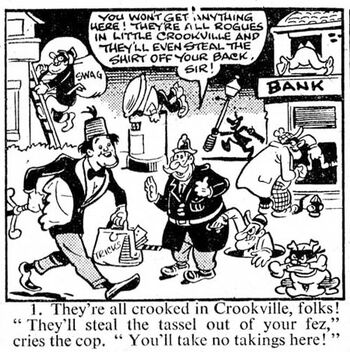
"Tommy Cooper, Film Fun, 1957
Albert Thomas "Charlie" Pease was born in Hackney, London, on 3 February 1905, the son of Albert David Pease, a cycle maker who owned two cycle shops in London and Brighton, and his wife May. He went to grammar school under a scholarship, but after his father died in a motorcycle accident in 1915 he had to drop out of school to help in the shop.
In 1923 he married Eileen Staddon in Southwark, London. Around 1925 he joined the Amalgamated Press as an office boy, having won an AP drawing competition in his late teens. When a regular artist fell ill he was asked to fill in for him on a single panel cartoon, and from then on he was a regular artist for the AP's comics.
He also wrote scripts for himself and other artists. He made two spinning cardboard wheels marked with words to help him come up with ideas - he would spin the wheels, and the resulting combination of words would be the starting point for a story. Rather than typing up the scripts he would rough them out on thin sheets of paper and send them to the editor, who would make any changes needed and return or send them on to the artist.
His first marriage ended about 1931, after which he hired a child-minder called Betty Baker, who he married in about 1933. In 1936 they moved to Coulsdon, Surrey. In 1942 he was called up by the army and sent for training, but was discharged with rheumatism and arthritis, and joined the Home Guard.
After the war he worked for small publishers like Martin & Reid (Merry Moments, 1948; Jolly Adventures (1949)), Philmar (Look and Laugh, 1949) and John Matthews (Merry Maker, 1948), as well as the Amalgamated Press.
Strips he drew included:
- "Ivor Klue" (1925), "Buck an' Nero" (1926-30), "Mighty Monk" (1930-40), "Laurie and Trailer" (1935-53), "Sally Sunshine" (1951-53), "Jimmy Joy the TV Boy" (1952-53), "Film Struck Fanny" and "Casey Court" for Illustrated Chips
- "Molly and Polly" (1926), "Bob Upp and Ben Downe (1927), "Fish and Chips" (1929) and "Cowboy Kid" (1929) for Butterfly
- "Darkie Mo and Jolly Juju" (1926), "Felix the Fat" (1926), "Plum and Duff" (1926-53) and "Wizzo Ranch" (1951-53) for Comic Cuts
- "Quackie the Duck" (1927-) for Tiny Tots
- "Dreamy Dick" (1928) for My Favourite
- "Charlie Chutney" (1930), "Alfie the Air Tramp" (1930-), "Harry the Hawker" and "Dickie Duffer" (1932-53) for The Joker
- "Freddie Flicker", "Betty and Baby Bill" and "P. C. Sparrow" for Sparkler (1934-39)
- "Dreamy Dennis" (1944) and "Charlie Chucklchops" (1945) for Jingles
- "Cardew Robinson" (1949) and "Stan Stennett" (1954) for Radio Fun
- "Artie the Autograph Hunter" (1950-54), "Our Jean" (1952) and "Billy Minds the Baby" (1954) for Tip Top
- "Inventor's Circle" (1953) for TV Fun
- "Ronald Shiner" (1954) and "Tommy Cooper" (1956-) for Film Fun
- "Billy Bunter" (1958-1963) for Knock-Out and Valiant
- "The Terrors of Tornado Street" (1961) for Buster
In December 1958 he had a heart attack, and was unable to work for some time while he recovered. By the time he was fit for work the AP had been bought out by the Mirror Group and been renamed Fleetway Publications. The new management made changes, letting a lot of veteran artists go and bringing in cheaper artists for Spain and Italy, but Pease's services were retained. He continued working until he suffered a second heart attack, this time fatal, on 10 February 1964. His younger brother, H. E. Pease, was also a comics artist. The strip "Charlie Peace", which ran in Buster from 1964 to 1974, was named after him.
References[]
- Alan Clark, Dictionary of British Comic Artists, Writers and Editors, The British Library, 1998, p. 132
- Alan Clark, "A. T. 'Charlie' Pease", The Sloperian #1
- Dennis Gifford, Encyclopedia of Comic Characters, Longman, 1987